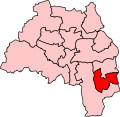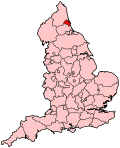Sunderland South (UK Parliament constituency)
Coordinates: 54°53′24″N 1°22′41″W / 54.890°N 1.378°W
| Sunderland South | |
|---|---|
|
Former Borough constituency for the House of Commons | |
|
Boundary of Sunderland South in Tyne and Wear for the 2005 general election. | |
|
Location of Tyne and Wear within England. | |
| County | Tyne and Wear |
| 1950–2010 | |
| Number of members | One |
| Replaced by | Houghton and Sunderland South, Sunderland Central |
Sunderland South was, from 1950 until 2010, a constituency represented in the House of Commons of the Parliament of the United Kingdom. It elected one Member of Parliament (MP) by the first past the post system of election.
The constituency was well known for trying to be the first seat to declare its results, doing so in the general elections of 1992, 1997, 2001 and 2005.[1]
History
Having been a Labour-Conservative marginal in the 1950s and 60s, Sunderland South was held by the Labour Party from 1964 until 2010, being represented by the politician and author Chris Mullin from 1987 until its abolition in 2010. Mullin did not contest the 2010 general election.
The constituency was well known for trying to be the first seat to declare its results, doing so in the general elections of 1992, 1997, 2001 and 2005.[1]
Boundaries
1950-1955: The County Borough of Sunderland wards of Bishopwearmouth, Hendon, Humbledon, Pallion, Park, St Michael's, Sunderland East, Thornhill, and West.
1955-1974: The County Borough of Sunderland wards of Bishopwearmouth, Hendon, Humbledon, Pallion, Park, Pennywell, St Michael's, Thorney Close, and Thornhill.
1974-1983: The County Borough of Sunderland wards of Bishopwearmouth, Hendon, Humbledon, Pennywell, Ryhope, St Chad's, St Michael's, Silksworth, Thorney Close, and Thornhill.
1983-1997: The Metropolitan Borough of Sunderland wards of Grindon, Hendon, Ryhope, St Chad's, St Michael's, Silksworth, Thorney Close, and Thornholme.
1997-2010: The City of Sunderland wards of Grindon, Hendon, St Chad's, St Michael's, Silksworth, South Hylton, Thorney Close, and Thornholme.
The constituency, as can be inferred from the name, formed the southern part of the City of Sunderland.
Boundary review
Following their review of parliamentary representation in Tyne and Wear, the Boundary Commission for England divided Sunderland South between two new constituencies, Houghton and Sunderland South and Sunderland Central. These new constituencies were first contested in 2010.
Members of Parliament
| Election | Member[2] | Party | |
|---|---|---|---|
| 1950 | Richard Ewart | Labour | |
| 1953 | Paul Williams | Conservative | |
| 1964 | Gordon Bagier | Labour | |
| 1987 | Chris Mullin | Labour | |
| 2010 | constituency abolished: see Houghton and Sunderland South & Sunderland Central | ||
Elections
Elections in the 1950s
| Party | Candidate | Votes | % | ± | |
|---|---|---|---|---|---|
| Labour | Richard Ewart | 27,192 | 49.6 | N/A | |
| Conservative | H. Wilkinson | 22,012 | 40.2 | N/A | |
| Liberal | Charles Jonathan Kitchell | 5,604 | 10.2 | N/A | |
| Majority | 5,180 | 9.5 | N/A | ||
| Turnout | 54,808 | 83.3 | N/A | ||
| Labour win (new seat) | |||||
| Party | Candidate | Votes | % | ± | |
|---|---|---|---|---|---|
| Labour | Richard Ewart | 27,257 | 50.3 | +0.7 | |
| Conservative | Paul Williams | 26,951 | 49.7 | +9.5 | |
| Majority | 306 | 0.6 | |||
| Turnout | 54,208 | 94.1 | |||
| Labour hold | Swing | ||||
| Party | Candidate | Votes | % | ± | |
|---|---|---|---|---|---|
| Conservative | Paul Williams | 23,114 | 48.6 | −1.1 | |
| Labour | Alexander G.S. Whipp | 21,939 | 46.1 | −4.2 | |
| Liberal | Roy Francis Leslie | 2,524 | 5.3 | N/A | |
| Majority | 1,175 | 2.5 | |||
| Turnout | 47,557 | ||||
| Conservative gain from Labour | Swing | ||||
| Party | Candidate | Votes | % | ± | |
|---|---|---|---|---|---|
| Conservative | Paul Williams | 24,727 | 51.9 | ||
| Labour | Ernest Armstrong | 22,953 | 48.1 | ||
| Majority | 1,774 | 3.7 | |||
| Turnout | 77.4 | ||||
| Conservative hold | Swing | ||||
| Party | Candidate | Votes | % | ± | |
|---|---|---|---|---|---|
| Conservative | Paul Williams | 27,825 | 50.9 | ||
| Labour | Ernest Armstrong | 26,835 | 49.1 | ||
| Majority | 990 | 1.8 | |||
| Turnout | 80.3 | ||||
| Conservative hold | Swing | ||||
Elections in the 1960s
| Party | Candidate | Votes | % | ± | |
|---|---|---|---|---|---|
| Labour | Gordon Bagier | 25,900 | 51.6 | ||
| Conservative | Paul Williams | 24,334 | 48.4 | ||
| Majority | 1,566 | 3.1 | |||
| Turnout | 50,234 | 75.8 | |||
| Labour gain from Conservative | Swing | ||||
| Party | Candidate | Votes | % | ± | |
|---|---|---|---|---|---|
| Labour | Gordon Bagier | 27,567 | 57.5 | ||
| Conservative | Philip Edwin Heselton | 20,398 | 42.5 | ||
| Majority | 7,169 | 15.0 | |||
| Turnout | 47,965 | 75.5 | |||
| Labour hold | Swing | ||||
Elections in the 1970s
| Party | Candidate | Votes | % | ± | |
|---|---|---|---|---|---|
| Labour | Gordon Bagier | 26,840 | 56.4 | ||
| Conservative | Denis Orde | 20,722 | 43.6 | ||
| Majority | 6,118 | 12.9 | |||
| Turnout | 47,562 | 70.1 | |||
| Labour hold | Swing | ||||
| Party | Candidate | Votes | % | ± | |
|---|---|---|---|---|---|
| Labour | Gordon Bagier | 28,296 | 49.6 | ||
| Conservative | Mark Thorpe Wright | 19,700 | 34.5 | ||
| Liberal | Wilfred John Nicholson | 9,098 | 15.9 | N/A | |
| Majority | 8,596 | 15.1 | |||
| Turnout | 57,094 | 75.2 | |||
| Labour hold | Swing | ||||
| Party | Candidate | Votes | % | ± | |
|---|---|---|---|---|---|
| Labour | Gordon Bagier | 28,623 | 55.0 | +5.4 | |
| Conservative | John Charles Buchanan Riddell | 15,593 | 30.0 | −4.5 | |
| Liberal | Wilfred John Nicholson | 7,828 | 15.0 | −0.9 | |
| Majority | 13,030 | 25.0 | |||
| Turnout | 52,044 | 68.1 | |||
| Labour hold | Swing | ||||
| Party | Candidate | Votes | % | ± | |
|---|---|---|---|---|---|
| Labour | Gordon Bagier | 29,403 | 53.1 | −1.9 | |
| Conservative | James Richard Harris | 21,002 | 37.9 | +7.9 | |
| Liberal | Paul Macdonald Barker | 4,984 | 9.0 | −6.0 | |
| Majority | 8,401 | 15.2 | |||
| Turnout | 55,389 | 70.0 | |||
| Labour hold | Swing | −4.9 | |||
Elections in the 1980s
| Party | Candidate | Votes | % | ± | |
|---|---|---|---|---|---|
| Labour | Gordon Bagier | 22,869 | 45.7 | −7.4 | |
| Conservative | Andrew Mitchell | 17,321 | 34.6 | −3.3 | |
| Social Democratic | John Anderson | 9,865 | 19.7 | ||
| Majority | 5,548 | 11.1 | |||
| Turnout | 50,055 | 66.6 | |||
| Labour hold | Swing | ||||
| Party | Candidate | Votes | % | ± | |
|---|---|---|---|---|---|
| Labour | Chris Mullin | 28,823 | 54.0 | +8.3 | |
| Conservative | George Howe | 16,210 | 30.4 | −4.2 | |
| Social Democratic | Keith Hudson | 7,768 | 14.6 | −5.1 | |
| Green | Douglas Jacques | 516 | 1.0 | N/A | |
| Majority | 12,613 | 23.7 | |||
| Turnout | 53,317 | 71.1 | |||
| Labour hold | Swing | +6.3 | |||
Elections in the 1990s
| Party | Candidate | Votes | % | ± | |
|---|---|---|---|---|---|
| Labour | Christopher Mullin | 29,399 | 57.9 | +3.9 | |
| Conservative | George Howe | 14,898 | 29.4 | −1.0 | |
| Liberal Democrat | John Lennox | 5,844 | 11.5 | −3.1 | |
| Green | Terence Scouler | 596 | 1.2 | +0.2 | |
| Majority | 14,501 | 28.6 | +4.9 | ||
| Turnout | 50,737 | 69.9 | −1.3 | ||
| Labour hold | Swing | +2.5 | |||
| Party | Candidate | Votes | % | ± | |
|---|---|---|---|---|---|
| Labour | Chris Mullin | 27,174 | 68.1 | +10.2 | |
| Conservative | Timothy Schofield | 7,536 | 18.9 | −10.5 | |
| Liberal Democrat | John Lennox | 4,606 | 11.5 | +0.0 | |
| UKIP | Margaret Wilkinson | 609 | 1.5 | N/A | |
| Majority | 19,638 | 49.2 | |||
| Turnout | 39,925 | 58.8 | −11.1 | ||
| Labour hold | Swing | +10.4 | |||
Elections in the 2000s
| Party | Candidate | Votes | % | ± | |
|---|---|---|---|---|---|
| Labour | Chris Mullin | 19,921 | 63.9 | −4.2 | |
| Conservative | James Boyd | 6,254 | 20.1 | +1.2 | |
| Liberal Democrat | Mark Greenfield | 3,675 | 11.8 | +0.2 | |
| BNP | Joseph Dobbie | 576 | 1.8 | N/A | |
| UKIP | Joseph Moore | 470 | 1.5 | N/A | |
| Monster Raving Loony | Rosalyn Warner | 291 | 0.9 | N/A | |
| Majority | 13,667 | 43.8 | |||
| Turnout | 31,187 | 48.3 | −10.5 | ||
| Labour hold | Swing | −2.7 | |||
| Party | Candidate | Votes | % | ± | |
|---|---|---|---|---|---|
| Labour | Chris Mullin | 17,982 | 58.6 | −5.3 | |
| Conservative | Robert Oliver | 6,923 | 22.5 | +2.4 | |
| Liberal Democrat | Gareth Kane | 4,492 | 14.6 | +2.8 | |
| BNP | David Guynan | 1,166 | 3.8 | +2.0 | |
| Monster Raving Loony | Rosalyn Warner | 149 | 0.5 | −0.4 | |
| Majority | 11,059 | 36.0 | |||
| Turnout | 30,712 | 49.3 | −1.5 | ||
| Labour hold | Swing | −3.9 | |||
See also
Notes and references
- 1 2 Daily Record; May 6, 2005; Sunderland Leads the Way
- ↑ Leigh Rayment's Historical List of MPs – Constituencies beginning with "S" (part 6)
- ↑ "Election Data 1983". Electoral Calculus. Archived from the original on 15 October 2011. Retrieved 18 October 2015.
- ↑ "Election Data 1987". Electoral Calculus. Archived from the original on 15 October 2011. Retrieved 18 October 2015.
- ↑ "Election Data 1992". Electoral Calculus. Archived from the original on 15 October 2011. Retrieved 18 October 2015.
- ↑ "Politics Resources". Election 1992. Politics Resources. 9 April 1992. Retrieved 6 Dec 2010.
- ↑ "Election Data 1997". Electoral Calculus. Archived from the original on 15 October 2011. Retrieved 18 October 2015.
- ↑ "Sunderland South". politicsresources.net.
- ↑ "Election Data 2001". Electoral Calculus. Archived from the original on 15 October 2011. Retrieved 18 October 2015.
- ↑ "Election Data 2005". Electoral Calculus. Archived from the original on 15 October 2011. Retrieved 18 October 2015.

